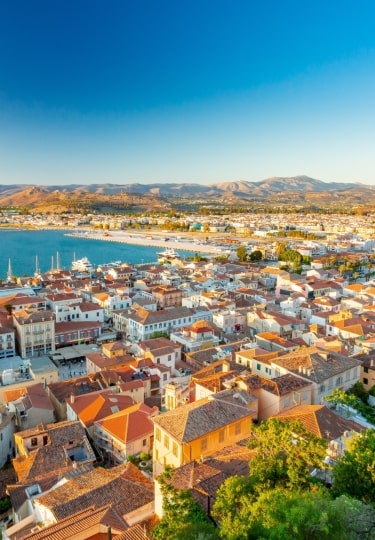Capital of the Argolis regional district on the Peloponnese, there are plenty of things to do in Nafplio, a beautiful port city and one of Greece’s most storied destinations.
Travelers are lured here by the long history, seafront location, high culture, and great outdoors. It’s also a prime spot from which to explore the eastern Peloponnese from historic Corinth as far as ancient Sparta. You certainly won’t run out of things to do in Nafplio.
Sip Coffee on Syntagma Square
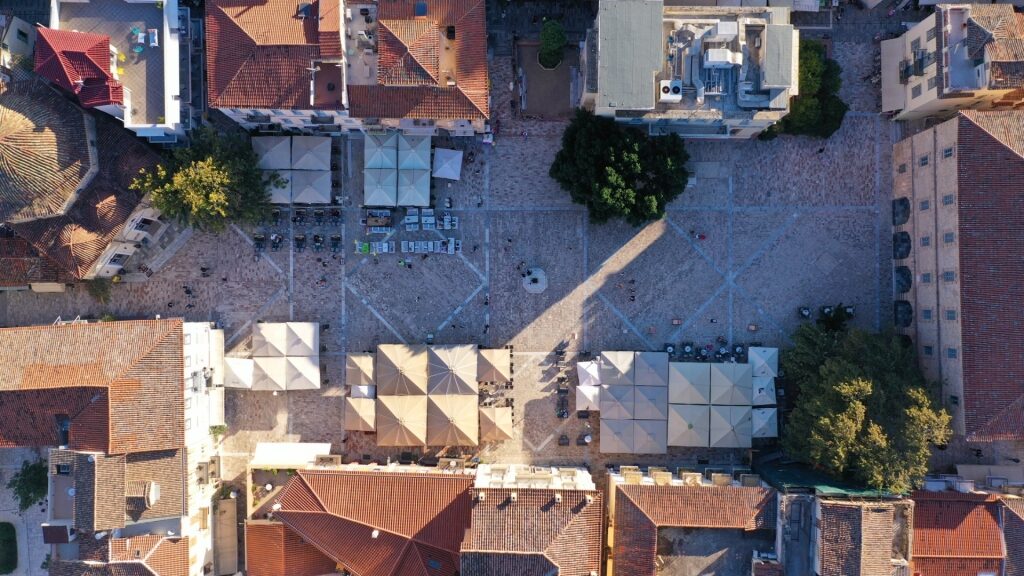
Syntagma Square
At the heart of Nafplio’s Old Town sits Syntagma Square: the focal point of the Greek revolution, home to some of the city’s most historic locations, and now a central gathering point.
Around the paved square, you will find the Archaeological Museum, the former mosque of Aga Pasha, and Greece’s first post-revolutionary parliament building. The edges of the square are also surrounded by bars and cafés, with the tables and chairs almost spilling into one.
It’s a great place to grab a coffee, snack, or ice cream, admire the elegant surrounding architecture, and watch the world go by as kids set up impromptu soccer games in the “free” space in the middle.
Stroll on Nafplio Promenade
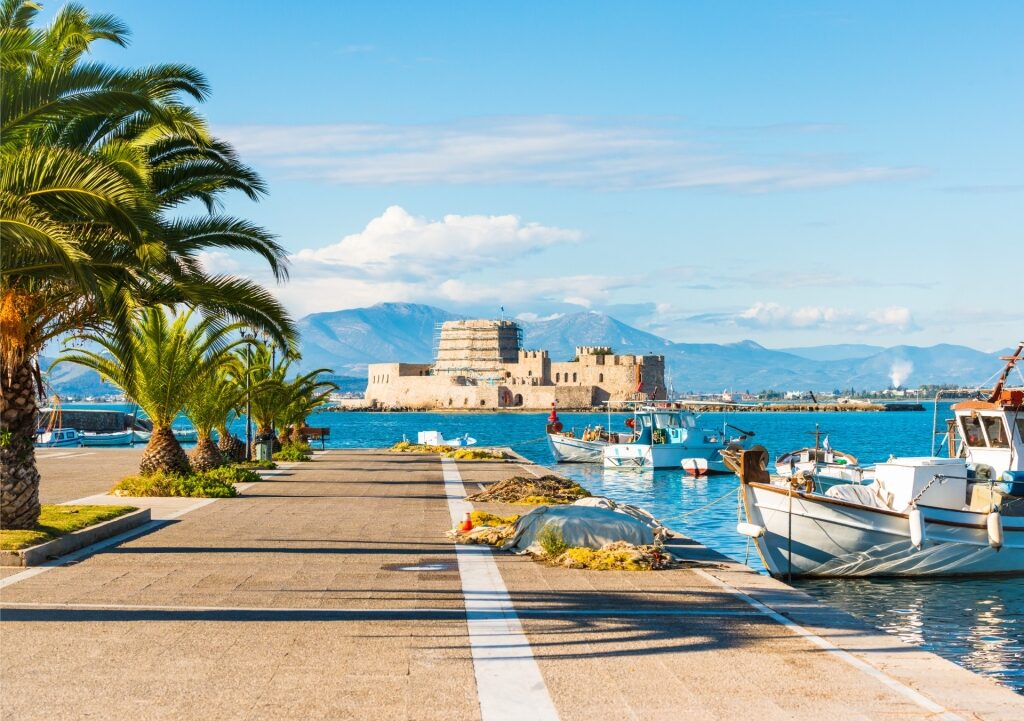
Nafplio Promenade
Most Greeks take an evening “volta” or stroll before settling down for coffee, and the perfect place to do it in Nafplio is the seafront promenade. This walk along the harbor front skirts around the Old Town on seafront Bouboulinas Avenue, before becoming a coastal trail that leads to Arvanitas Beach and beyond.
The coastal road takes its name from Laskarina Pinotsi, commonly known as Bouboulina—a Greek heroine of the War of Independence and the first woman to be designated an admiral, who led the blockade of the city in the early days of the war.
Visit the Archaeological Museum of Nafplio
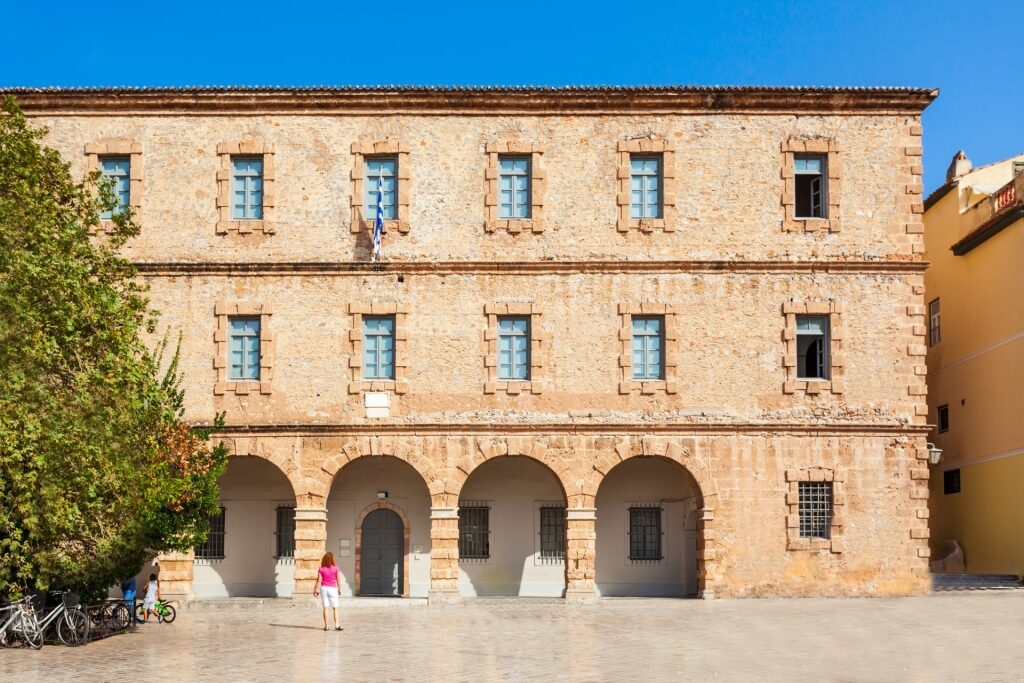
Archaeological Museum of Nafplio
Set over two floors of the 18th-century Venetian barracks that overlook Syntagma Square, Nafplio’s Archaeological Museum gained museum status in 1926.
Permanent exhibits take visitors through the history of the surrounding Argolis region from the Paleolithic period until Roman times. Considered one of the best things to do in Nafplio, it houses objects from Mycenae and Epidaurus, with a highlight being a bronze armor from Dendra that dates from the 15th century BC
Summit the Palamidi Fortress
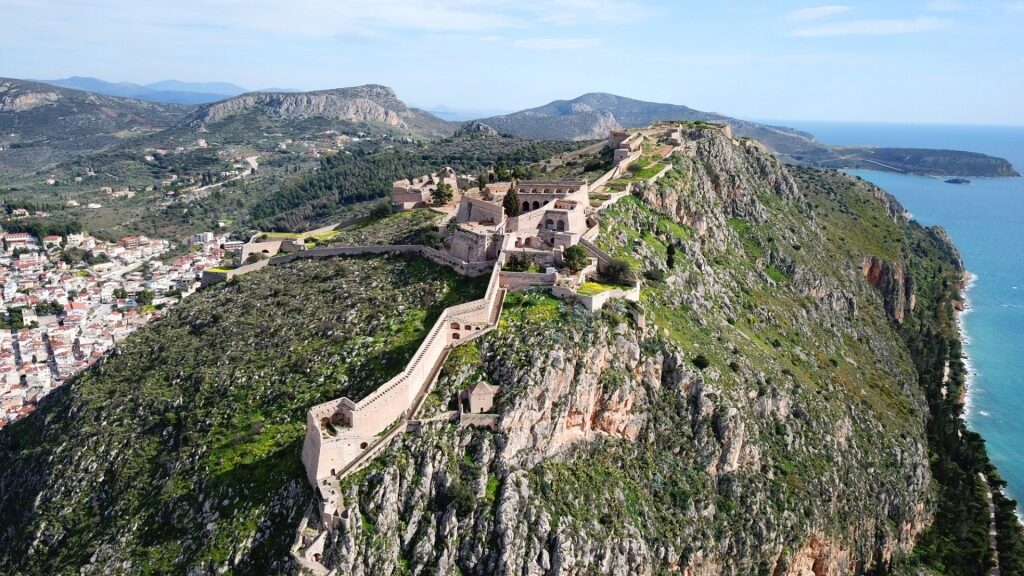
Palamidi Fortress
Like many Greek islands and strategic mainland cities around the Aegean, Nafplio was long under Venetian rule, and several important castles and bastions that were used as defenses are spread around the city.
The highlight of these is probably Palamidi, an imposing 17th-century castle that sits on a 700-foot hill and dominates the skyline. You can drive to the summit, but a more authentic way is to hike up the 999 steps that lead to this Greek castle. You may see the 999 used on restaurant menus to attract you to certain dishes.
It’s not an easy climb—comfortable shoes, water, and sunscreen are all highly recommended—but it’s rewarded with both the chance to see the castle itself and to admire the impressive views over the Argolic Gulf.
Take a Boat to the Bourtzi Sea Castle
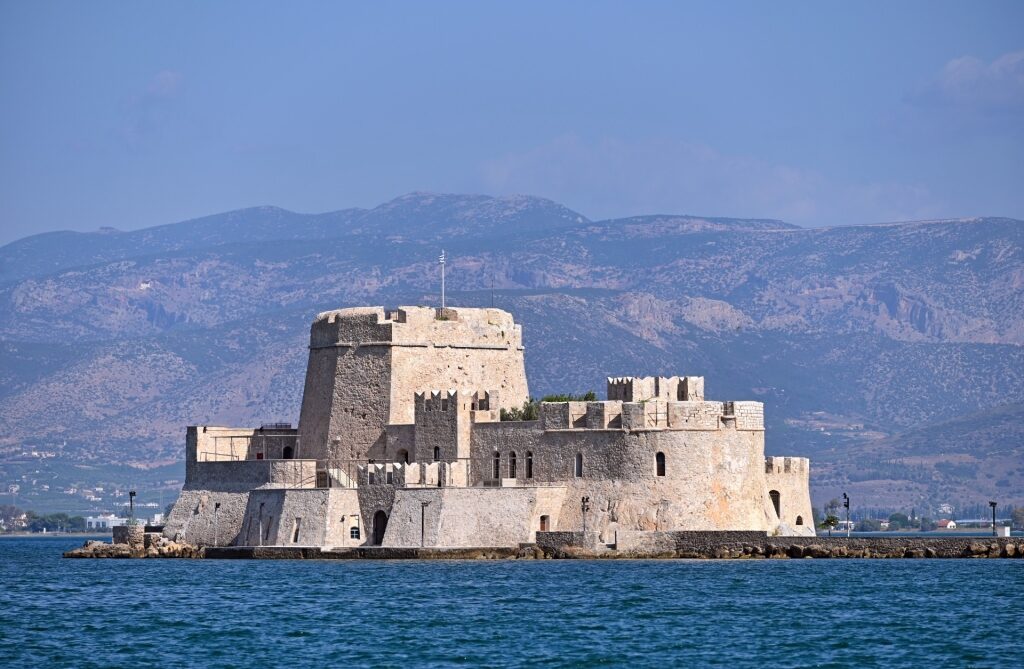
Bourtzi Sea Castle
Dating from the 15th-century Venetian era, Bourtzi is along with Palamidi one of the city’s icons. If you’re wondering what to do in Nafplio, a visit here is worthwhile.
Sitting on a small island in the middle of the harbor, Bourtzi dominates sea views in the city, just as Palamidi does the vistas inland.
Used over the years as a fortress, prison, and even a luxury hotel, it is now accessible as a tourist site via a short boat ride from the harbor. Within its imposing walls, there’s now a small exhibition space, a souvenir shop, and a café.
See Acronafplia Fortress
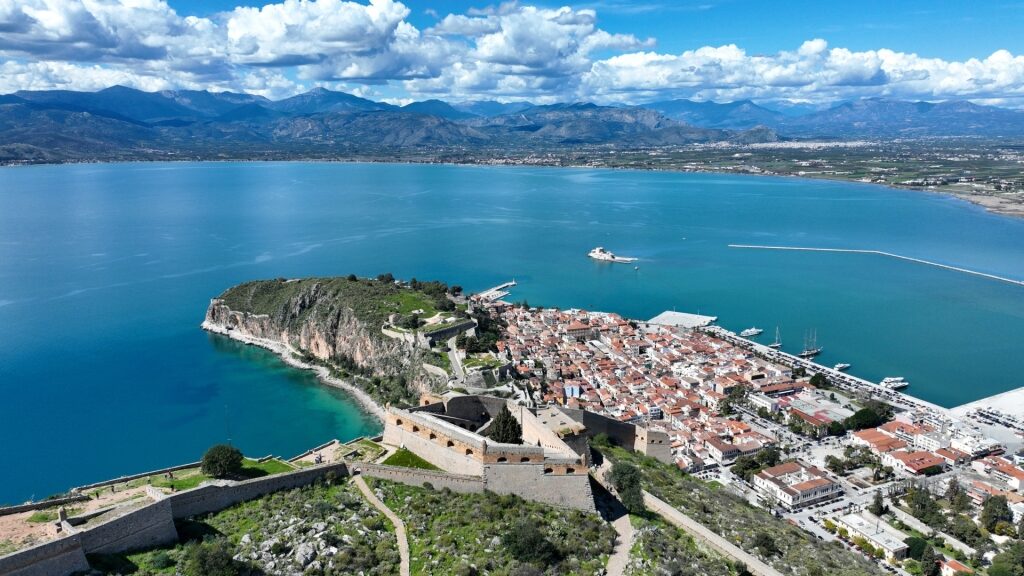
Acronafplia Fortress
With views of Bourtzi and in the shadow of Palamidi lies Nafplio’s oldest castle, Acronafplia. Set on a rocky peninsula to the southwest of this Greek city, it is thought to date from the 4th century BC with its name being a conjunction of Acropolis of Nafplion.
Over the centuries, the original castle was extended and added to by the Romans, Venetians, Ottomans, and Franks, and today provides a pleasant walk around the old castle walls.
Photograph the Cannons at Five Brothers Bastion
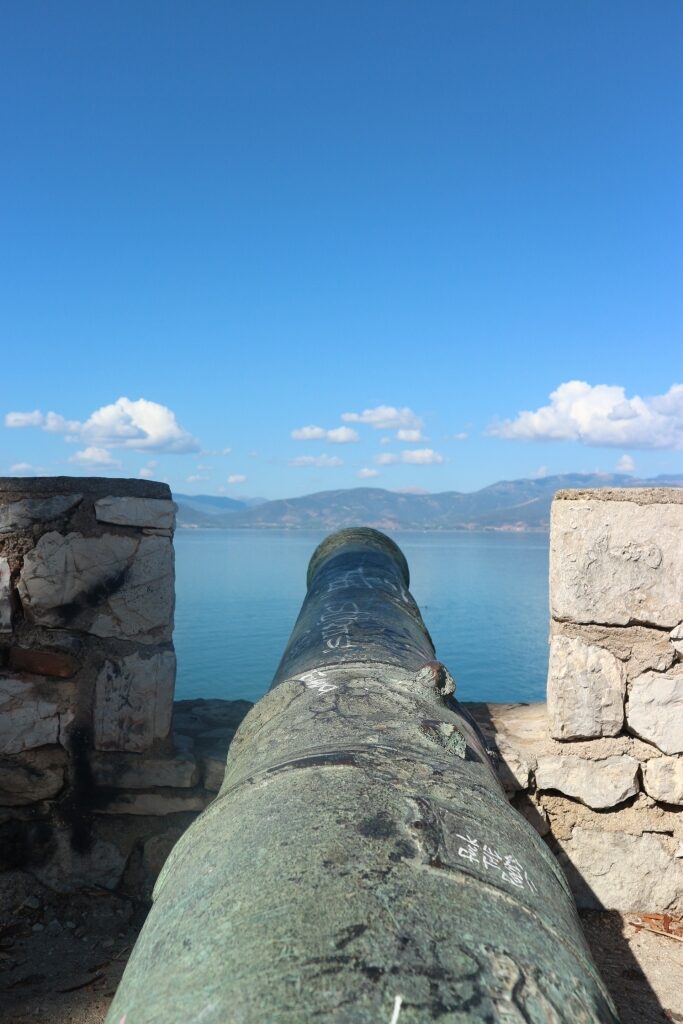
Five Brothers Bastion
Five Brothers, in Greek, “Pende Adelphia”, is the last standing bastion of Nafplio, designed, along with Bourtzi, to protect the port of the city—although it remains unclear whether it was built by the Venetians or Ottomans.
Set on the northwest side of Akronafplia and constructed some time towards the end of the 15th century, it takes its name from the five magnificent bronze cannons that still point out to sea, making for a great social-media-worthy photo op.
Visit the City’s Churches
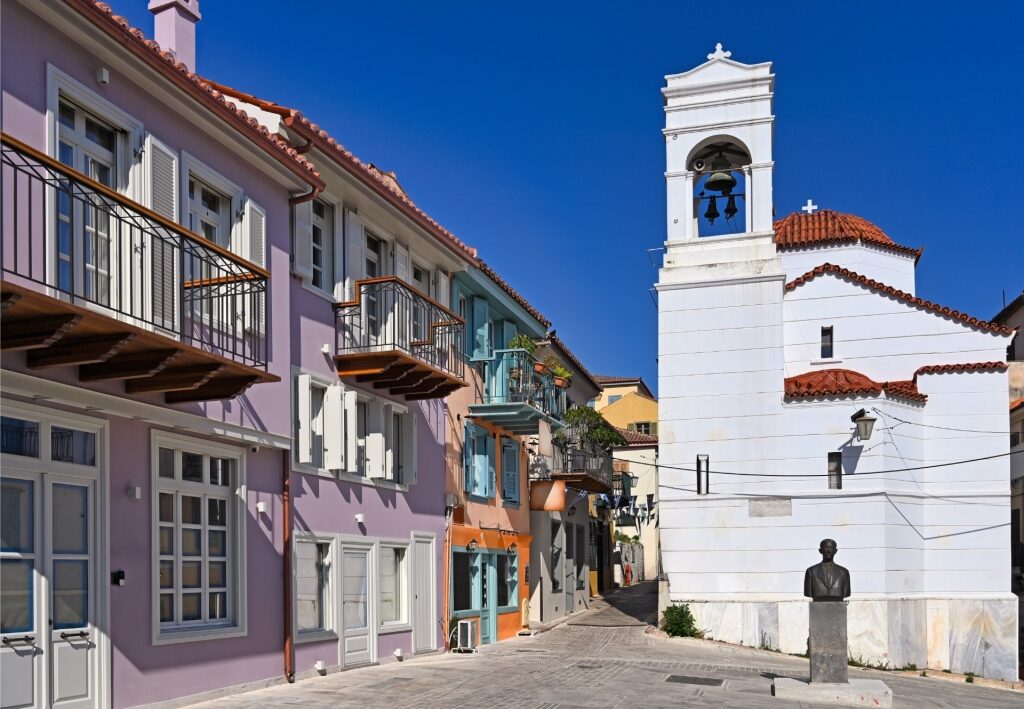
Church of Agios Spyridon
Like all Greek towns and cities, Nafplio has a large number of churches, mostly offering historical reasons for visiting. Two of them should definitely be on your list of what to do in Nafplio.
First up is the Church of Agios Spyridon. Built in the Old Town in 1702, it not only includes some impressive religious icons, but it also played an important role in Greek history. This is the place where Ioannis Kapodistrias, the first governor of the new Greek state, was assassinated in 1831. The bullet holes from the assassination can still be seen in the church walls.
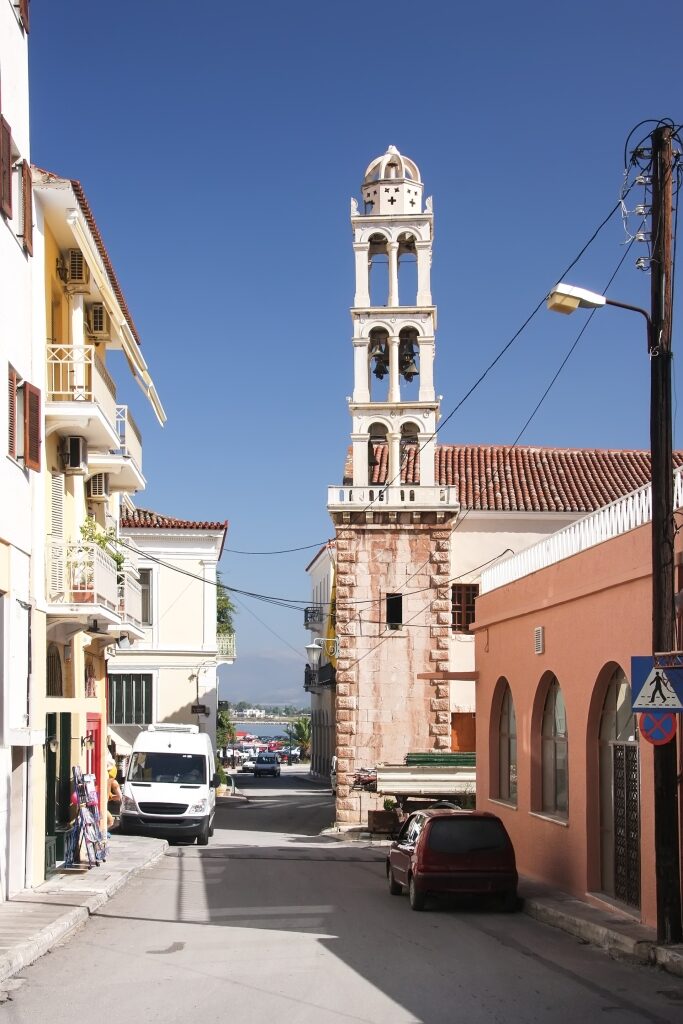
Church Of Panagia
The other is the Church Of Panagia, dedicated to the birth of the Virgin Mary and sitting behind the Archaeological Museum. With parts of it dating from the 15th century, it, too, has historical significance. On February 1, 1655, Anastasios, patron saint of the city, was martyred by Ottoman occupiers beside an olive tree that still stands to the north of the temple.
Pick up Souvenirs at the Komboloi Museum
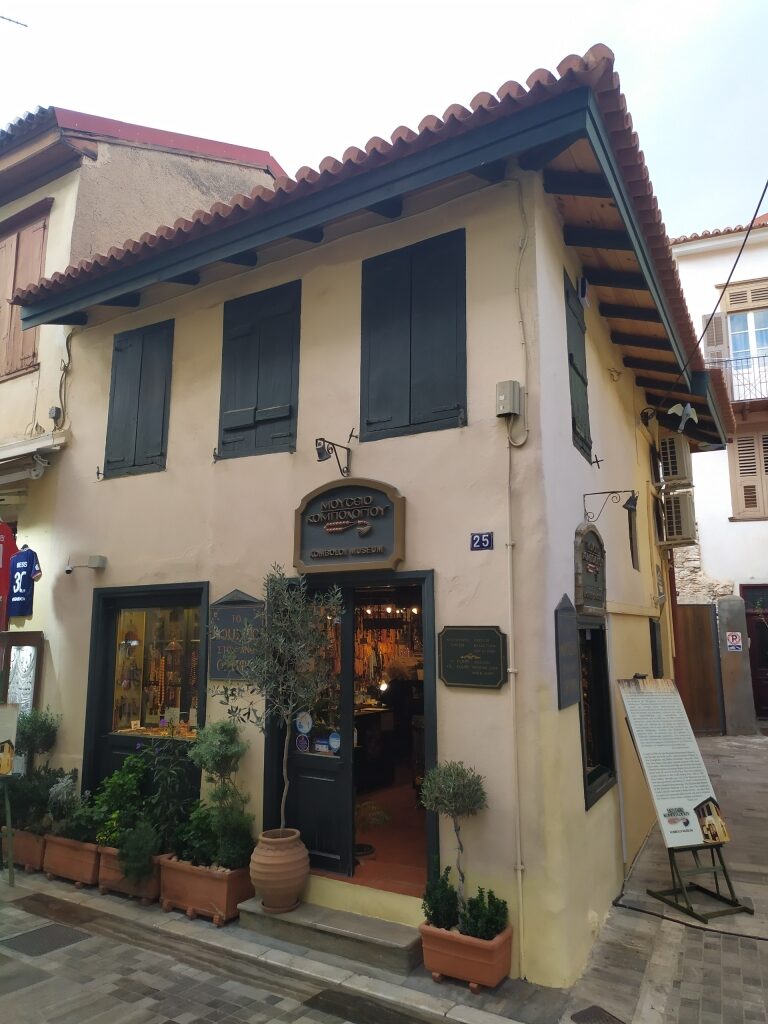
Komboloi Museum Photo by Vanbasten 23 on Wikimedia Commons, licensed under CC BY-SA 3.0
Sit in a Greek café long enough and you’ll hear two clicking sounds. One will be the dice of a backgammon game, the other the twirl of worry beads, or “komboloi”. These small chains of beads are twirled artistically around the fingers in Greek and Cypriot culture, and have various uses from stress relief to smoking cessation.
This unique museum displays a number of pieces from down the ages, including some of incredibly high value made from amber. As well as the displays, there’s also an obligatory museum shop from where you can pick up beads from simple Greek souvenirs to antique sets.
Relax by the Lion of Bavaria
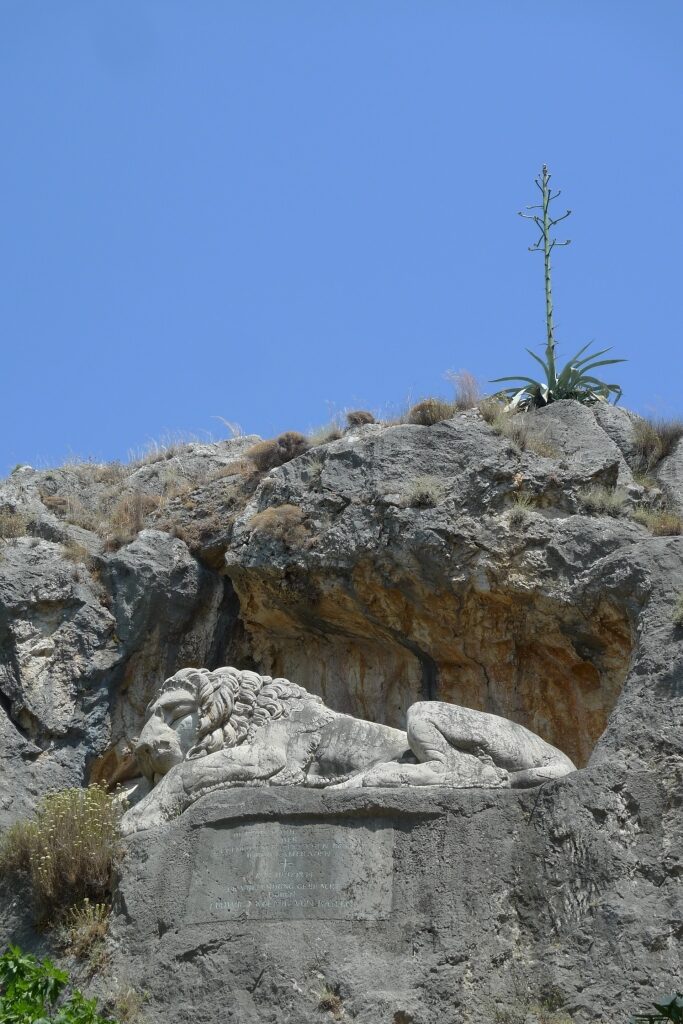
Lion of Bavaria
The 1831 assassination of Ioannis Kapodistrias almost brought anarchy to the newly formed Greek state causing the powers of the day—Britain, France, and Russia—to step in to create The Kingdom of Greece. Prince Otto of Bavaria was named as the first King.
On arrival to take up the throne in 1833, he brought 3,500 Bavarian soldiers with him to act as bodyguards, many of whom lost their lives in a typhoid epidemic. The king then commissioned this rock sculpture to be carved in their honor.
Modeled on France’s Lion of Lucerne, the incredibly detailed carving is one of the largest in the country, and there’s a pleasant park with benches that makes for a great spot for calm reflection.
Swim on Arvanitias Beach
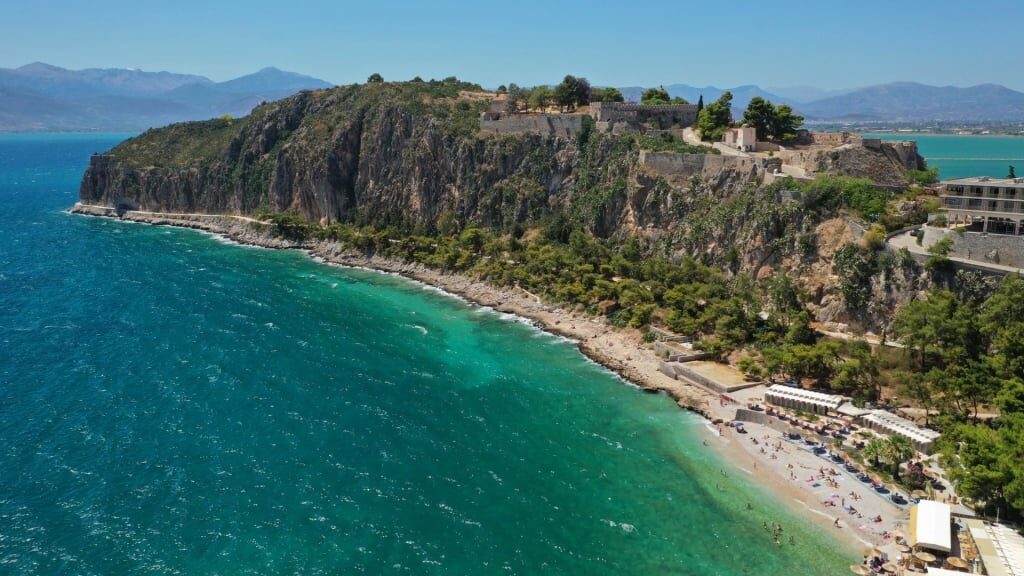
Arvanitias Beach
As the beachfront promenade of Bouboulinas turns into a coastal trail around Acronafplia, the town’s beaches and coves start to reveal themselves. Best of the lot and one of the best things to do in Nafplio is Arvanitias beach.
This wide, sandy beach in Greece has a gently shelving sea floor making it a great spot for swimmers of all levels. There’s plenty of shade, too, thanks to the surrounding rocks, as well as a café/taverna offering drinks and snacks, and lounge chair and umbrella rental.
Those feeling a little more daring can venture further down the coastal path to find the clothing-optional rock beach at Limanakia.
Walk Over the Corinth Canal
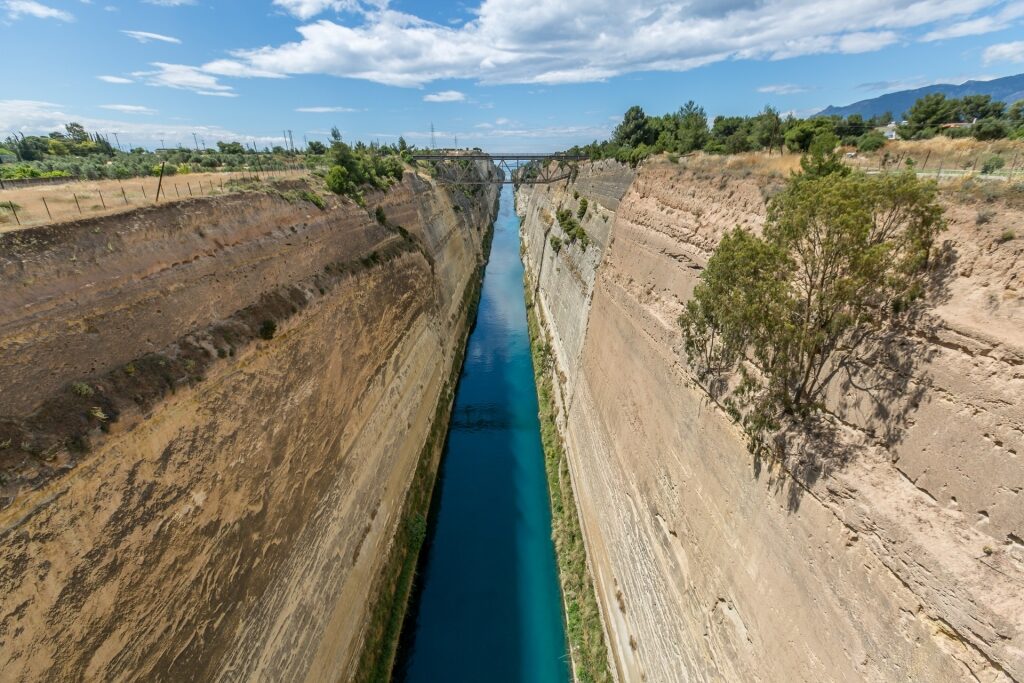
Corinth Canal
An hour’s drive north of Nafplio outside the city of Corinth is one of Greece’s most impressive architectural wonders of the 19th century, the Corinth Canal.
The idea of cutting through the Isthmus of Corinth, a narrow land bridge that connects the mainland to the Peloponnese, to speed up sailings from from the Aegean to the Ionian seas had been around since antiquity. But it was not until 1881 that a project to create a canal began.
Taking 12 years to complete, the four-mile canal is too narrow to be used by large vessels—and it’s prone to landslides due to the surrounding sedimentary rock. But it is no less impressive because of these flaws.
The canal can be crossed in two ways, one via a foot-and-road bridge that offers dizzying views and the chance to see the occasional bungee jumper. The other is at the village of Isthmia at the canal’s south-eastern entrance where there is a unique submersible bridge.
Perform at the Theatre of Epidaurus
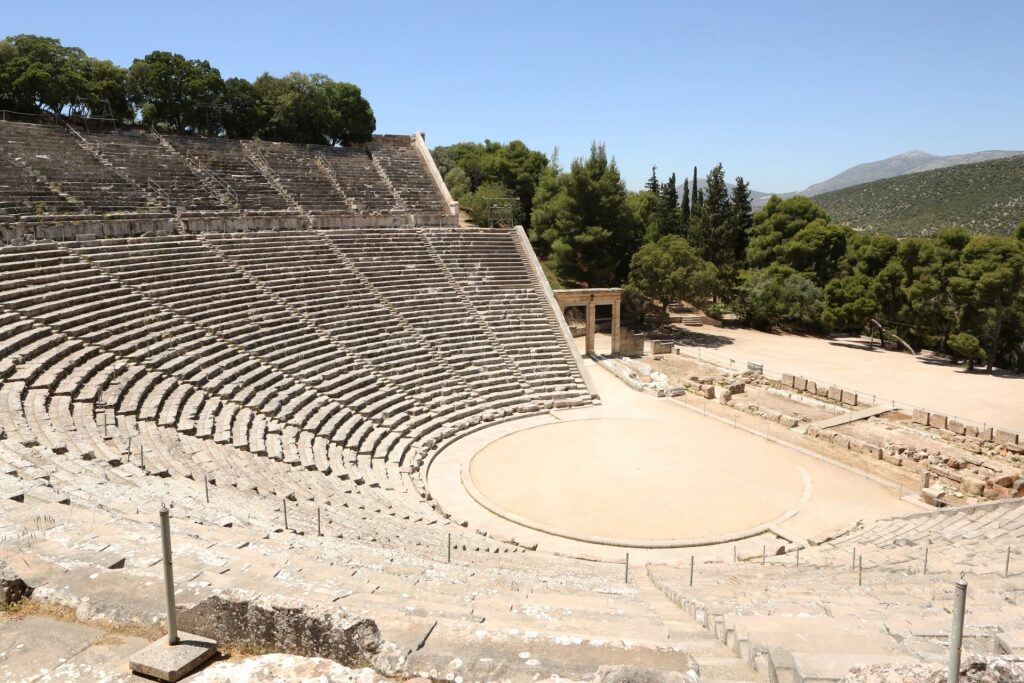
Theatre of Epidaurus
Outside of the antiquities of Athens, the Ancient Theatre of Epidaurus is one of Greece’s most recognizable archaeological sites. A 30-minute drive from Nafplio, the theater is regarded as the best-preserved of its kind in Greece, and with seating up to 15,000 people, its perfect acoustics can still be sampled today.
Take in one of the many shows that are still performed here, or perform your own experiment. Stand on the stage, send a friend to the very back row and whisper something. Providing the ambient noise is not too high, you should be able to hear them loud and clear.
Rub the Foot of King Leonidas in Sparta
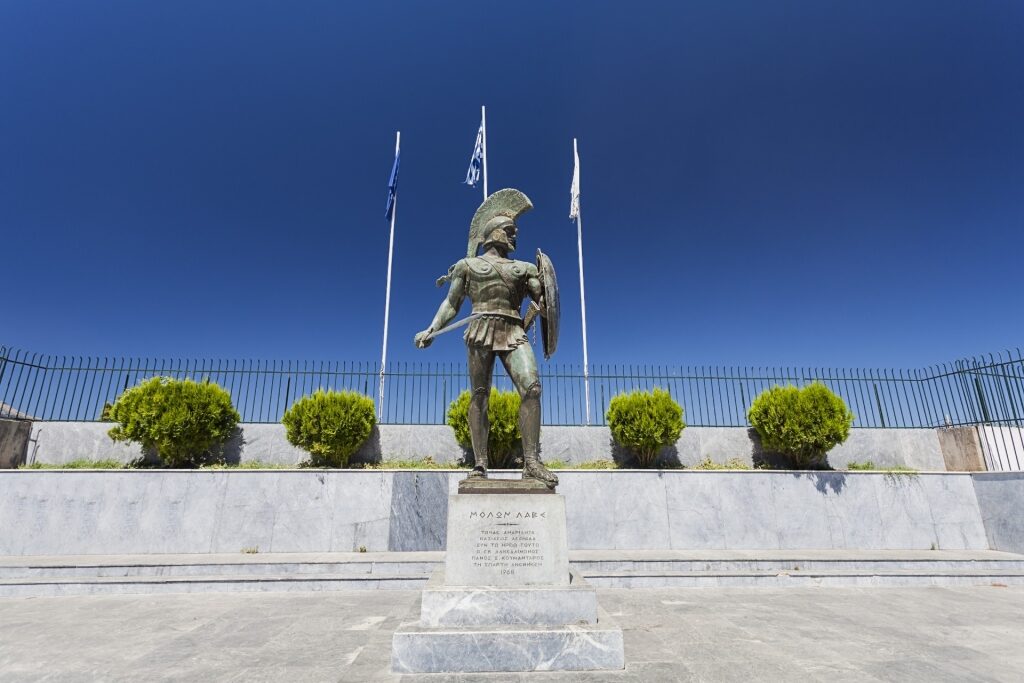
King Leonidas Statue, Sparta
Back in ancient times when Greece was a collection of city-states, the fighting qualities of the men and women of the city of Sparta, 90 minutes south of Nafplio, were legendary. So much so that tales of their valor have been made into several Hollywood films.
At the heart of many of the city’s legends is King Leonidas who famously led 300 warriors to take on the Persian army at the 480BC Battle of Thermopylae. It was a pyrrhic victory for the Persian invaders, as word of the spirit of the Spartans spread far and wide, fuelling resistance in the other city-states.

King Leonidas Statue, Sparta
There’s a statue in Leonidas’ honor on Triakosion Street in Sparta, with the shiny bronze toes of the statue said to bring luck to all that rub them. If visiting at the end of September, check out the finish here of the Spartathlon race.
Based on the story of an ancient “day runner” called Pheidippides, the 153-mile run from Athens to Sparta is widely regarded as the toughest race in the world.
See the Ruins at Mycenae
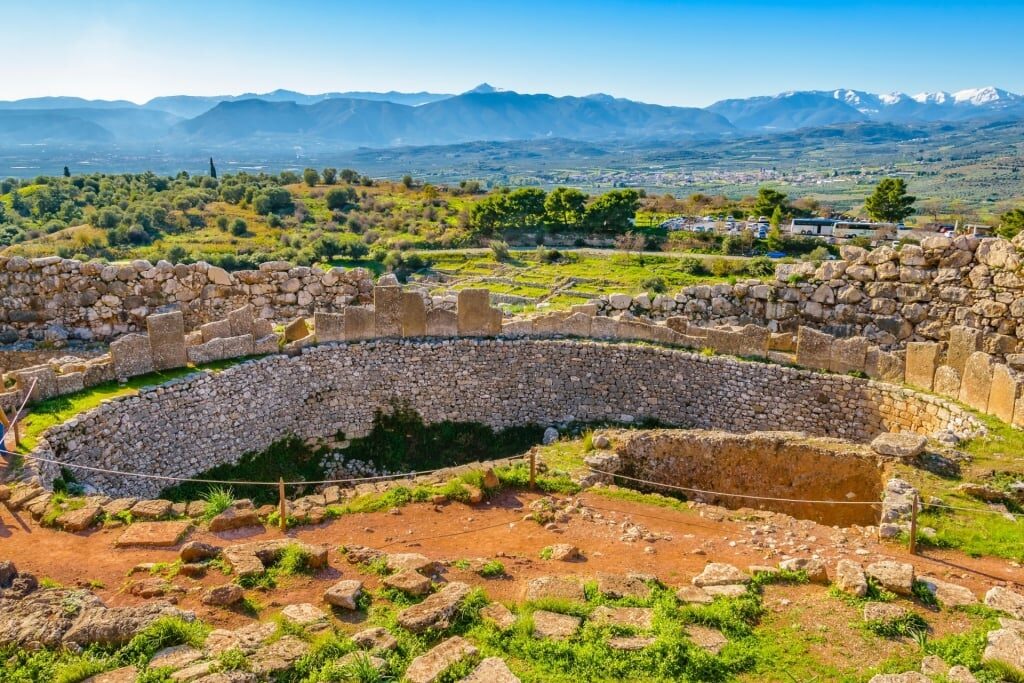
Mycenae
According to legend, Mycenae, a 30-minute drive from Nafplio, was Achaea, a regional capital ruled over by Agamemnon, who led the Greek forces in the Battle of Troy. Such was its glory it was described by Homer as having wide streets paved with gold, and it was one of the leading cities of late-Bronze era Greece.
Mycenae is now the principal late Bronze Age site on mainland Greece. Excavations of the Greek ruins began in 1840, with legendary archaeologist Heinrich Schliemann making the most celebrated discoveries.
Now a World Heritage site, it is famed for its Lion Gate entrance and the Treasury of Atreus—the tomb of King Agamemnon. There’s also an onsite Archaeological Museum, and a modern settlement nearby with cafés and restaurants.
Run in the Ancient Nemea Stadium
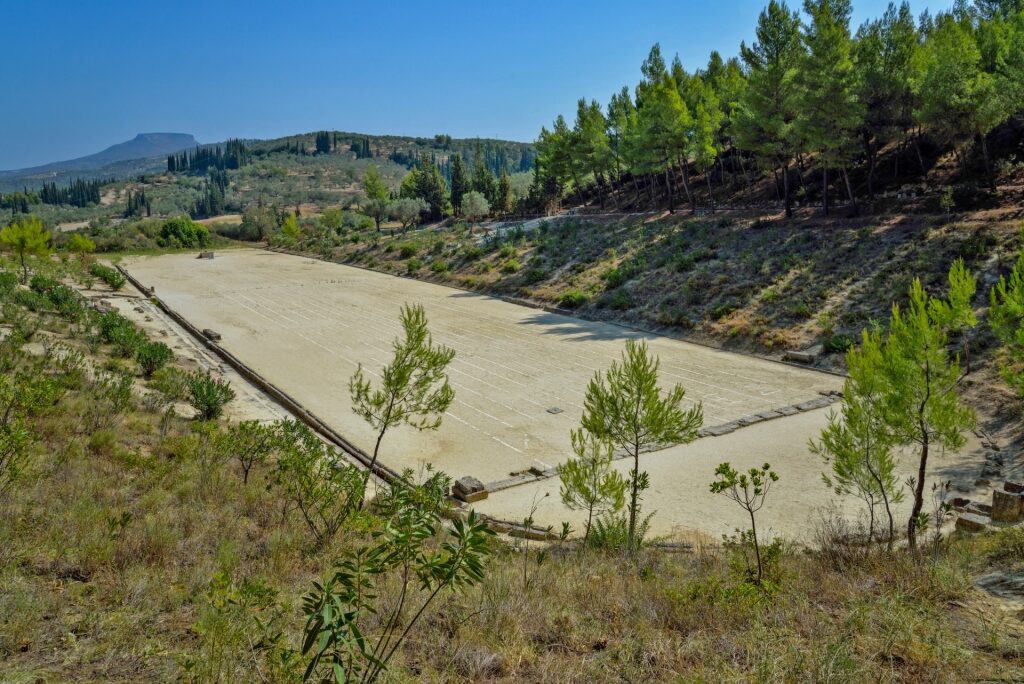
Nemea Stadium
Today we widely recognise the Olympics as the birthplace of ancient Greek games but there were actually four Panhellenic Games held in rotation in antiquity, one of which was at Nemea in the central Peloponnese.
A 40-minute drive north of Nafplion, the stadium for these ancient contests was excavated by Stephen Miller of the University of California, Berkeley, in the mid 1970s. Miller scouted the area for months looking for the most likely spot for the stadium’s location.
Today you can visit and run the length of the stadium at any point in time, even better if you visit during the revival Nemean Games that take place every four years and see competitors face off in toga races in the stadium.
Read: Unique Places to Visit in Greece
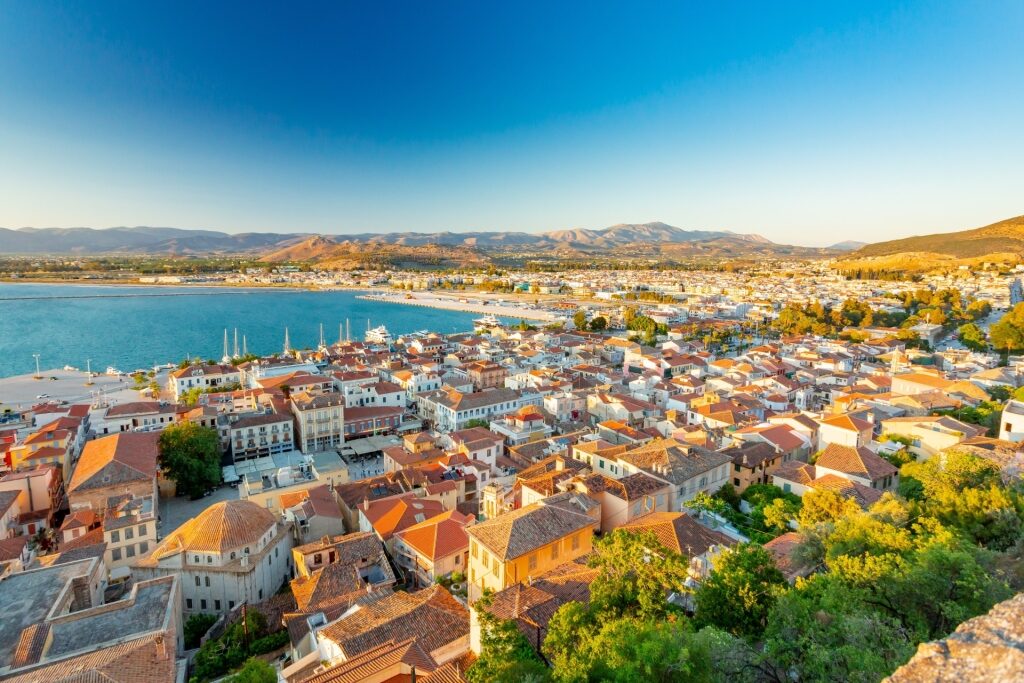
Nafplio
Ready to find out more about the wonders of Nafplio? Browse Celebrity’s cruises to Nafplio and plan your own voyage of discovery.
